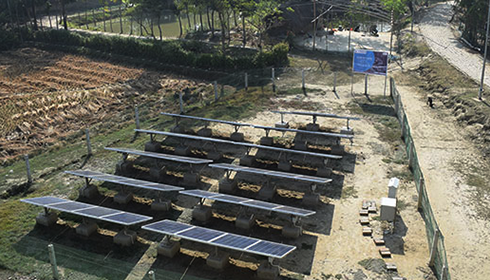
An energy access project towards the sustainable
development of Indian Sundarbans.
The Indian Sundarbans is a network of low-lying islands in the Bay of Bengal, separated from one another. This isolation from each other and the mainland, makes last mile connectivity a huge challenge. Access to modern and reliable energy services is a challenge for forest fringe island. Of the 54 islands inhabited by humans in the Sundarbans, the southernmost island is the Satjelia Island, with approximately 8,293 households. Like most islands, Satjelia too is energy deficient. Conventional grid electricity has been extended to this island very recently. However, affordability of conventional grid based electricity in the area remains a challenge. Furthermore, the Sundarbans landscape is prone to frequent and high intensity weather events like storm, tropical cyclone and flooding which puts the entire conventional electrical grid under risk. The standalone Solar PV systems/ micro grids are therefore a viable option for sustainable energy solutions for island based communities in Sundarbans.
In Sunderbans, West Bengal, before SEIF’s interventions, the rural households were using kerosene for the purpose of lighting. Needs assessment was carried out to determine the electricity consumption of the households and electricity needs and their willingness to pay for these services were ascertained. Furthermore, need for proper street lighting was also felt. Installation of solar lights have helped the rural communities to go out of their homes post-sunset, for instance. Similarly, in the Sundarbans, prior to the project, tiger attacks were frequent, and people were afraid to leave their homes at night. With the installation of street lights human-tiger encounters and attacks have reduced, people in the village also expressed that snake bites have reduced due to solar street lights in the villages.
More than 3255 beneficiaries - 80 nos. Street Lights
• Clean Electricity to 651 families
• 6 DC micro grids 73.18 KW of combined capacity
• Community owned operated and managed microgrids
Project Sahastra Jyoti, a joint initiative of Schneider Electric India and WWF India was launched in 2016 with an objective of lighting up a thousand forest fringe households in the Indian Sundarbans through solar powered energy access solutions. The Satjelia island was chosen as the pilot island for the solar project, among 46 other forest fringe villages. 60% of electrified households belong to below the poverty-line.
The micro grids provide grid quality electricity round the clock at affordable price to homes, some small businesses and rural institutions (schools, disaster relief shelter etc.) in remote forest fringe hamlets of the Indian Sundarbans. The energy systems have been planned, designed and installed in consultation with Village Energy Committees who manage and operate these systems. These community-owned, managed and operated solar micro grid systems are helping forest fringe communities to move in the trajectory of sustainable development.